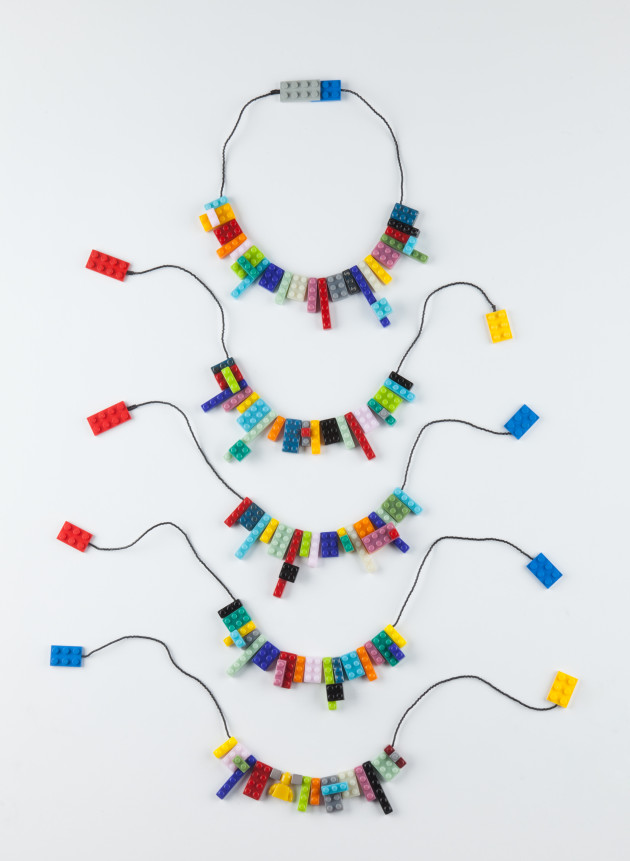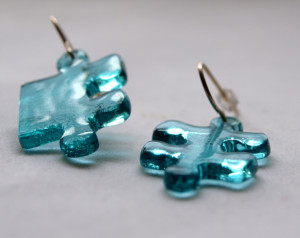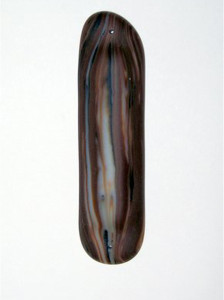The Lilith Blog 1 of 2
June 2, 2017 by Eleanor J. Bader
How This Jewish Glass Artist Juggles Work and Family

The first thing I notice about artist Dena Pengas is her asymmetrical, bold, and multi-colored jewelry. At first glance, it appears as if her necklace is made of Lego pieces, but as I get closer I realize that each rectangle is, in fact, glass. The overall effect is elegant, whimsical, and wonderfully cheerful. Later, when we talk, she tells me that she hopes that this piece—one of many that she has created—will “spark nostalgia is the wearer and viewer.”
The 38-year-old Brooklyn-based Pengas recently spoke to me about her work. As the conversation moved from topic to topic, we touched upon parenthood, marriage, work-family balance, and what it means to be socially responsible in a time of backlash and retrenchment.
Eleanor J. Bader: When did you begin making art?
Dena Pengas: I was always experimenting with different kinds of art as a kid. In high school I did a lot of beading and some painting and basically used whatever materials I could get my hands on. Making stuff has always been my outlet.
I finished high school in 1997, went to Israel the following year, and then began studying at New York University in the fall of 1998. At NYU I double-majored in psychology and theater, but throughout college I made jewelry at home. At that point I mostly worked with beads and metal and designed bracelets, cuffs, earrings and earpieces. I’d wear my creations when I went out and people would stop me to ask about what I had on. I sold quite a few pieces of my jewelry to strangers right there on the street!
During the same time, I met some artists from Kiln Enamel and began working with them and making enameled jewelry. Then, in my third year at NYU, I learned that they were offering a for-credit glass-making course at a studio called UrbanGlass in Brooklyn. I got wait-listed for the class but was finally able to enroll a few weeks into the semester. One day I wore some of the jewelry I had made, and one of the artists, Erica Rosenfeld, mentioned that she liked my work. Her work is beautiful—at the time she was working on kiln-formed jewelry with intricate beadwork—so of course I told her that I loved it. She asked if I wanted to work for her, which I did, and that was really my deep-dive into glass kiln-forming and the UrbanGlass community. My experience with her taught me so much and, best of all, Erica is now one of my best friends.
I’ve been connected to UrbanGlass ever since. I’ve taught there, taken many classes, and studied with many different glass artists affiliated with them. UrbanGlass has given me an education about glass that was more like a traditional apprenticeship. I’m forever grateful.
EJB: Why work with glass?
DP: Glass is a really challenging and temperamental material but it’s incredibly gratifying when you get it to do what you want; it’s also really inspiring and exciting to learn from it when it doesn’t. So many awesome things come from the mistakes. There are also many ways you can work with glass—fusing, casting, neon, lampworking, blowing—and I’ve made so many objects, from jewelry to Judaica to housewares, from it. My work now mainly focuses on small-scale castings and fusing, which I particularly love since it gives me a lot of flexibility.
EJB: How difficult has it been to juggle glassmaking with raising your son?
DP: Very. But let me step back before I fully answer that. When my husband and I decided to start our family, having to deal with infertility and the medical interventions that were necessary became like a second full-time job. It was really tough emotionally and financially. It was also time consuming.
Throughout the process, teaching at UrbanGlass was a big part of my life. While trying to conceive, I was giving private lessons, teaching classes to larger groups, and making various lines of jewelry and Judaica. Then, when Oz, our son, was born 22 months ago, I had to turn the room in our apartment that I’d been using as a studio into his bedroom. This meant that I had to move my glass baby so that I could install my human baby in the space.
Thankfully, before Oz was born, I worked really hard to make a lot of raw elements—Lego beads and puzzle pieces—so that I now don’t have to make as much as often and can use what I already have to create new work. I’m pregnant again—due in late August or early September—but I hope that at some future point I’ll be able to have a small studio of my own somewhere in Brooklyn. Working at home is fun, but glass can be dangerous and it’s not the easiest or safest material to work with in an apartment when there are little kids around.
But let me get back to the question about work-life balance… I feel confident putting more time into motherhood right now, though I miss my glass work and community. I’m still making art, of course, just not as much. This is my choice. It’s what I want to do. Being a mom is as important to me as making art. Motherhood informs every decision I make. It informs my politics—my belief in equality, fairness, equal access to resources, as well as my disbelief and horror about the Trump agenda. But no matter what, I feel lucky—I know I’m lucky—to have the freedom to be an artist and to be a mom.
EJB: Where did the idea for the Lego and puzzle piece jewelry come from?
DP: Several years back I had the opportunity to work as a Teaching Assistant to an artist in Scotland. We were exploring the theme of home, and for some reason I started working on jigsaw puzzles and Lego-like pieces. I liked the tangible, bright, and tactile interplay of using glass as a toy. I’d always liked Legos growing up and I enjoyed doing puzzles to see how things fit together. I made a few pieces of jewelry with these designs and each time I wore them people approached me and told me stories about their childhood relationship to games and playthings.
EJB: Can you talk about your Judaica work?
 DP: Sure. I felt like a lot of Judaica that my parents were buying for gifts was overly ornamented—not that that’s a bad thing in any way. I couldn’t find a lot of alternatives. I wanted a simple, clean, minimalist mezuzah for my apartment, so I made one myself. I wanted the pieces to be accessible to people of different aesthetics and religious backgrounds.
DP: Sure. I felt like a lot of Judaica that my parents were buying for gifts was overly ornamented—not that that’s a bad thing in any way. I couldn’t find a lot of alternatives. I wanted a simple, clean, minimalist mezuzah for my apartment, so I made one myself. I wanted the pieces to be accessible to people of different aesthetics and religious backgrounds.
My Judaica draws on Middle Eastern art and the ethnic influences that come from my family background. My dad was born in Athens, spoke Ladino as a first language, and grew up in Israel. My mom was born to fresh-off-the-boat Holocaust survivors from Poland so I was raised around several different cultures. Taken together, they inform and affirm my strong Jewish sense of self.
My father has been a musician for his entire life. He sings and plays the guitar and bouzouki. For a while he owned a Middle Eastern club in Manhattan’s West Village, near where I grew up. My mother’s art was dancing, but she was the one who worked a 9:00-5:00 job as an administrator at NYU. I had a sort of hippie upbringing, but after my Bat Mitzvah, I joined Young Judea and it changed my life. I met Jews from all over, one of whom I married. I spent a year with them in Israel and went to a Young Judea summer camp as a teenager. All of this influences my art and my Judaica collection blends Jewish heritage with a modern aesthetic.
EJB: Has the Judaica collection been well received?
DP: Yes. In fact, interest in it increased after photos of a few pieces I’d made were included in a book called 500 Judaica: Innovative Contemporary Ritual Art that was published by Lark Press in 2010.
EJB: Does your work try to impart any type of message?
DP: Well, if I can make a piece of jewelry that makes the person wearing it feel empowered, if it gives them voice and confidence, I’ve achieved my goal.
EJB: What’s next for you?
DP: I have a new line of glass jewelry using mostly float glass and resin to make clear, grey, and light blue earrings that catch the light as the wearer moves. It’s totally different than the game series of jewelry. The line will eventually incorporate wood and metal, but there’s a new baby on the way, so we’ll see when that happens. Too many ideas, never enough time!
The views and opinions expressed in this article are the author’s own and do not necessarily reflect those of Lilith Magazine.
 Please wait...
Please wait...